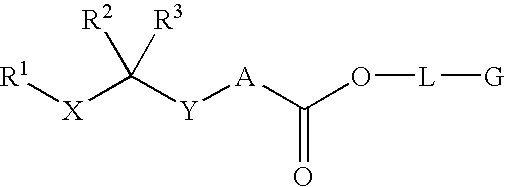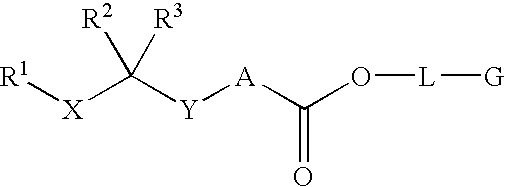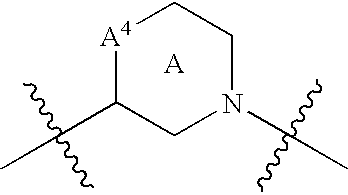Renin inhibitors
a renin inhibitor and inhibitor technology, applied in the field of renin inhibitors, can solve the problems of insufficient soluble renin inhibitors that can be prepared on a large scale, high cost of goods, and the inability to develop several compounds in the clinical field, and achieve the effect of treating or ameliorating a renin mediated disorder
- Summary
- Abstract
- Description
- Claims
- Application Information
AI Technical Summary
Benefits of technology
Problems solved by technology
Method used
Image
Examples
preparation 1
(S)-1-(3-chloro-2-fluorophenyl)-5-methoxy-1-((R)-piperidin-3-yl)pentan-1-ol
[0253]
Step 1. (R)-tert-butyl 3-(3-chloro-2-fluorobenzoyl)piperidine-1-carboxylate
[0254]2.5 M BuLi in hexane (40 mL, 0.1 mol) was added dropwise over 45 min to a stirred solution of 1-chloro-2-fluoro-benzene (13.0 g, 0.1 mol) in THF (250 mL) at −75° C. After additional stirring for 30 min at −75° C., a solution of (R)-tert-butyl 3-(methoxy(methyl)carbamoyl)-piperidine-1-carboxylate (21.76 g, 0.08 mol) in THF (100 mL) was added dropwise over 30 min. The mixture was allowed to warm to 0° C. The mixture was quenched with sat'd aq. NH4Cl, extracted with EtOAc (3×) and the combined organic layers were dried over Na2SO4. Solvent removal and flash column chromatography, eluting with 5% EtOAc / PE, afforded (R)-tert-butyl 3-(3-chloro-2-fluorobenzoyl)piperidine-1-carboxylate (19.2 g, 70%). 1H NMR (400 MHz, CDCl3): δ=1.45 (s, 9H), 1.63 (m, 2H), 1.76 (m, 1H), 2.06 (m, 1H), 2.87(m, 1H), 3.15(m, 1H), 3.25 (m, 1H), 3.9 (m, 1H...
preparation 2
Methyl (S)-4-(3-chlorophenyl)-4-hydroxy-4-((R)-piperidin-3-yl)butylcarbamate
[0257]
Step 1. [3-(2,2,5,5-tetramethyl-1-aza-2,5-disilacyclopent-1-yl)propyl]magnesium bromide
[0258]A 250 mL round bottom flask was charged with magnesium turnings (0.528 g, 21.7 mmol, 1.16 equiv) and THF (10 mL). The flask was degassed and heated to 100° C. A small crystal of iodine was then added. A solution of 1-(3-bromopropyl)-2,2,5,5-tetramethyl-1-aza-2,5-disilacyclopentane (5.239 g, 18.7 mmol, 1.0 equiv) in THF (15 mL) was added dropwise to the boiling THF mixture over 10 min. The reaction mixture was stirred and heated under reflux for 2.5 h and most of magnesium was consumed. The resulting Grignard reagent (A) was used in the next step.
Step 2. (R)-tert-butyl 3-((S)-4-amino-1-(3-chlorophenyl)-1-hydroxybutyl)piperidine-1-carboxylate
[0259]To a 250 mL, round bottom flask were added (3-chlorophenyl)((R)-N-Boc-piperidin-3-yl)methanone (0.800 g, 2.47 mmol) and THF (10 mL). The flask was evacuated and refille...
preparation 3
(R)-1-(3-Chloro-2-fluorophenyl)-5-methoxy-1-((R)-morpholin-2-yl)pentan-1-ol
[0262]
Step 1. (R)-2-(Benzyloxymethyl)morpholine
[0263]2-Aminoethyl hydrogen sulfate (36.8 g, 255.8 mmol) was added in portions to a stirred mixture of (R)-2-(benzyloxymethyl)oxirane (10.0 g, 60.9 mmol) and NaOH (19.49 g, 487.2 mmol) in H2O (46 mL) and MeOH (18 mL). After addition, the reaction mixture was stirred at 40° C. for 2 h. After cooling to rt, the mixture was treated with NaOH (15.0 g, 375.0 mmol), then toluene (70 mL) and stirred at 65° C. overnight. The mixture was cooled, diluted with toluene (27 mL) and H2O (92 mL). The toluene layer was separated and the aqueous layer was extracted with CH2Cl2 (2×50 mL). The combined organic layers were concentrated to give crude (R)-2-(benzyloxymethyl)morpholine (˜14 g), which was used without purification. MS m / z 208 (M+H+).
Step 2. (R)-tert-Butyl 2-(benzyloxymethyl)morpholine-4-carboxylate
[0264]To a solution of crude (R)-2-(benzyloxymethyl)morpholine (˜14 g) in...
PUM
| Property | Measurement | Unit |
|---|---|---|
| diameter | aaaaa | aaaaa |
| diameter | aaaaa | aaaaa |
| diameter | aaaaa | aaaaa |
Abstract
Description
Claims
Application Information
 Login to View More
Login to View More - R&D
- Intellectual Property
- Life Sciences
- Materials
- Tech Scout
- Unparalleled Data Quality
- Higher Quality Content
- 60% Fewer Hallucinations
Browse by: Latest US Patents, China's latest patents, Technical Efficacy Thesaurus, Application Domain, Technology Topic, Popular Technical Reports.
© 2025 PatSnap. All rights reserved.Legal|Privacy policy|Modern Slavery Act Transparency Statement|Sitemap|About US| Contact US: help@patsnap.com



